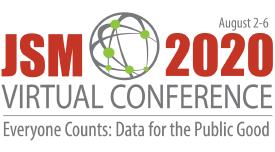Poster Tips
A poster session is a presentation in which materials such as maps, photographs, graphs, charts, and/or tables are posted on a display board along with brief textual summaries of your work. Ideally, a well-constructed poster will be self-explanatory. Successful poster presentations are those that achieve both coverage and clarity.
For JSM 2020, all poster presentations will be uploaded in advance of JSM to ConferenceContent. Instructions will be sent by email (from no-reply@conferencecontent.net) no later than July 22, with uploads due July 29.
Poster presentations can be uploaded in one of two formats:
Video: Video poster presentations should be uploaded in .mp4 format and be at least 1280 x 720 in dimension. Recordings should not exceed five minutes in length.
Flat PDF: PDF files for your poster presentation should not exceed 500 MB.
Poster presentations will be available for attendees to view on demand. Please be sure to check your poster for any questions that have been submitted throughout JSM, but particularly during your assigned session date and time. There will be a designated chat window for your poster, where you can interact with attendees and answer questions.
Formatting Tips
- Less is more. Be clear and concise with poster design and content. Overcrowding a poster makes it difficult to read.
- Use fonts that are large enough to read at a distance.
- Include your name and title in a larger, bolder font than you use throughout the rest of your poster.
- Provide clear labels or headings for each section of your presentation.
- Remember contrast. Put light-colored fonts on dark backgrounds and dark fonts on light-colored backgrounds so your viewers can see your text clearly.
- Imbed high-quality graphics and videos.
- If uploading a video presentation, avoid hyperlinks. Instead, links can be provided in the dedicated chat window on the platform for your presentation.
Content Tips
Coverage: In addition to title/author and abstract, most successful posters provide brief statements of introduction, method, subject, procedure, results, and conclusions. Ask yourself the following:
- Have I provided all the obvious information?
- Will a casual observer walk away understanding my major findings after a quick perusal of my material?
- Will a more careful reader learn enough to ask informed questions?
- What would I need to know if I were viewing this material for the first time?
Clarity: People attending a poster session will have difficulty reading excessive text and small fonts. With this in mind, we recommend you do the following:
- Use large fonts and limit text to essential information. Place your major points in the poster and keep the nonessential, but interesting, sidelights for informal discussion.
- Keep content simple and communicate clearly.
- Consider whether the sequence of information is evident. Indicate the order of your material with numbers, letters, or arrows when necessary.
- Use captioned illustrations, photographs, graphs, video, or other types of visually appealing material. “A picture is worth a thousand words.”
- Make your conclusions or summary a concise statement of your most important findings.
Online Resources for Poster Creation and Templates
These sites may provide other useful templates and tips for preparing your e-poster. Be sure to adjust any template using the formatting tips provided above for best display on the ASA’s monitors.
